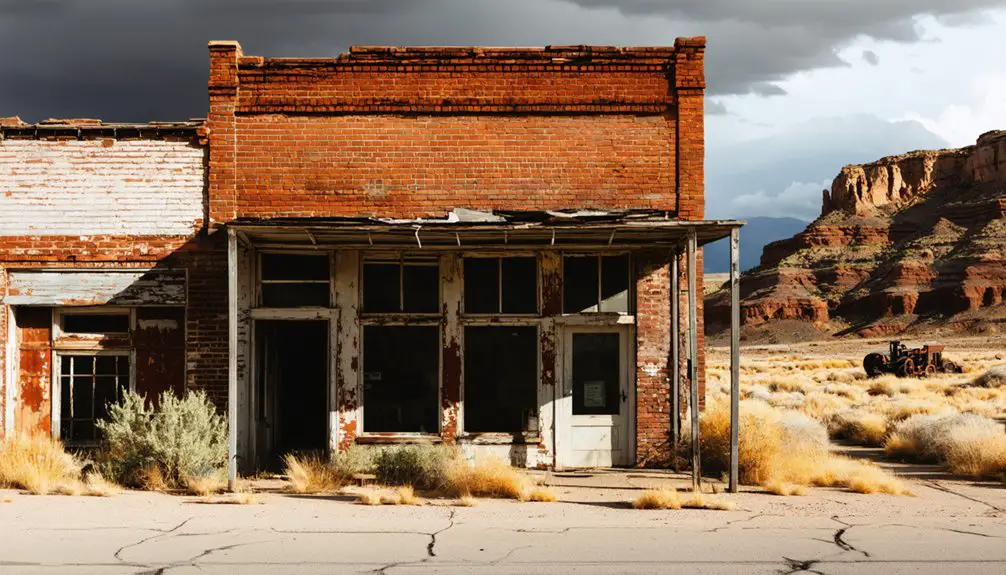You’ll find Standardville’s abandoned remains 5 miles northwest of Helper, Utah, where Fred A. Sweet built his model mining town in 1911. This pioneering community featured steam-heated homes, tree-lined streets, and modern amenities rare for its time. After surviving a devastating 1930 mine explosion and reaching peak production during WWII, the town couldn’t weather post-war economic changes. The silent streets and deteriorating structures hold countless stories of triumph and tragedy.
Key Takeaways
- Standardville, established in 1911 as a model mining town, now stands abandoned following the decline of coal demand after World War II.
- Once home to 33 different ethnic groups and modern amenities, the town featured steam-heated homes, hospitals, schools, and recreation facilities.
- A devastating mine explosion in 1930 killed 20 miners and three rescue workers, marking a significant turning point for the community.
- The town’s economy collapsed when miners worked only for food due to post-war financial struggles, leading to widespread abandonment.
- Standardville’s remains serve as testament to early 20th-century mining innovation, featuring ruins of planned industrial and residential areas.
The Birth of a Model Mining Town
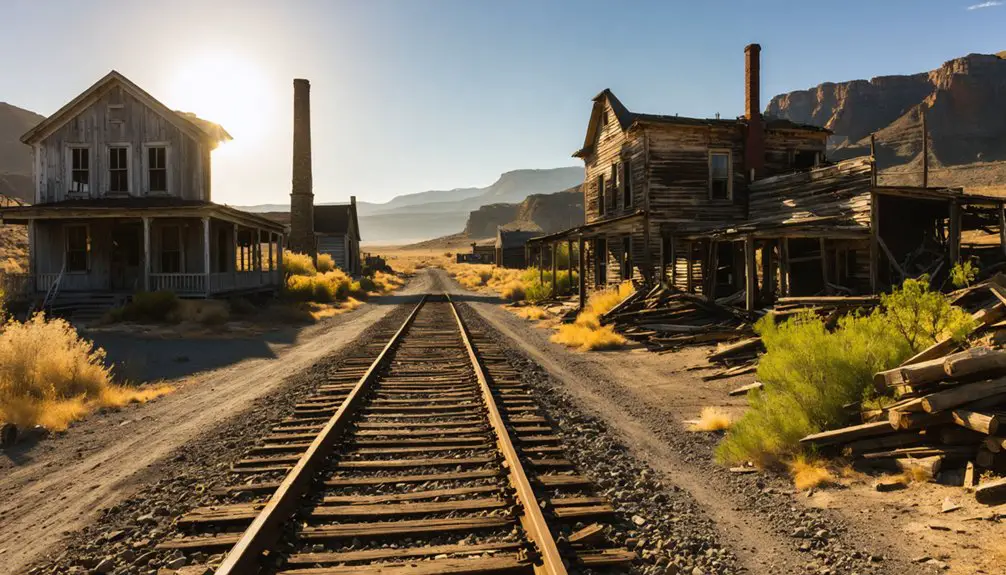
When Fred A. Sweet established the Standard Coal Company in 1911, he envisioned more than just another mining camp. His discovery of coal in Spring Canyon led to the creation of Standardville, located 5 miles northwest of Helper, Utah.
By 1914, the company’s community design set a new template for mining towns, featuring steam-heated homes, well-maintained lawns, and rows of poplar trees. The community was so well-planned that Standardville became a model town for other mining settlements to follow.
The rail infrastructure, including Denver & Rio Grande Railroad extensions and sidings, supported coal shipments that grew from 200 tons daily in 1914 to over 149,000 tons annually by 1915. The town’s impressive production was made possible by 143 mine workers employed by 1915.
You’d have found a complete town with everything from a company store and hospital to tennis courts and a bandstand. This carefully planned community offered miners and their families modern amenities that were rare for the era.
From Tents to Steam-Heated Homes
The early settlers of Standardville began their mining careers living in simple canvas tents, a stark contrast to Sweet’s grand vision for the model town.
You’ll find that tent living characterized the first four years of the settlement, while coal production ramped up to 200 tons daily by 1914.
By 1917, residents enjoyed the comforts of a well-planned community with modern amenities.
Planning the Perfect Coal Community
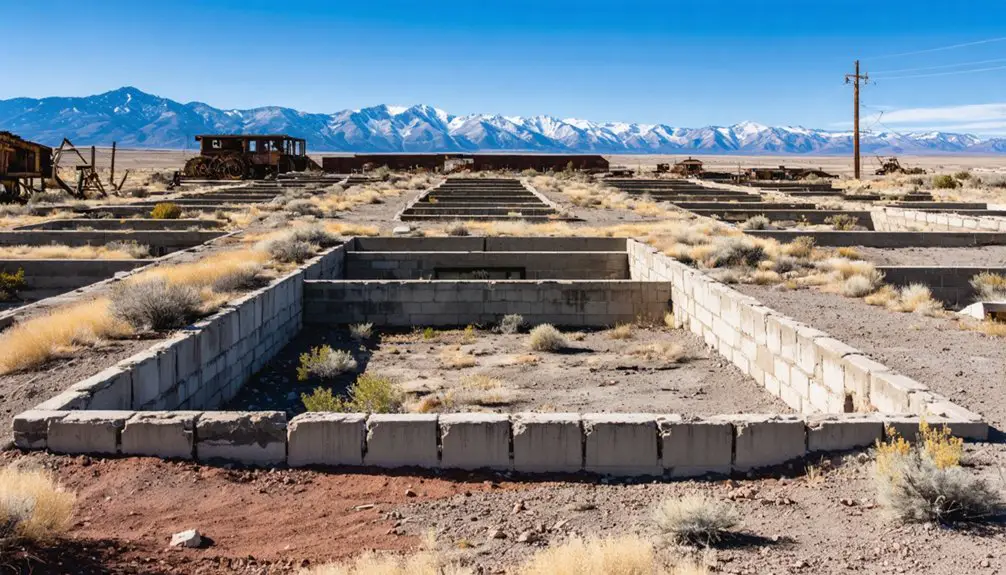
Founded in 1912, Standardville emerged as a meticulously planned coal mining community that would set new benchmarks for company towns across Utah. The Standard Coal Company’s community design showcased coordinated industrial planning, with the mine positioned just a quarter mile from residential areas for easy worker access.
You’d have found a thoughtfully arranged town complete with well-maintained lawns, poplar trees, and diverse amenities. Like their neighbor Peerless Coal Company, they focused heavily on providing modern housing for workers. The company’s industrial planning prioritized both function and comfort, equipping the community with steam-heated apartments, a hospital, school, recreation hall, and tennis courts. During its peak operations, the town supported miners who helped produce 2,000 tons of coal per day during World War II.
Daily Life in Utah’s Carbon County
Life in Carbon County’s mining communities revolved around a complex social tapestry woven from over 33 different ethnic groups by 1920. You’d find daily routines centered on the demanding work in the mines, while cultural festivals, shared religious celebrations, and communal activities like wine-making and ham-smoking brought people together across ethnic lines. Many immigrant families from Slavic countries settled in these close-knit communities.
In company towns, you’d have your rent automatically deducted from your paycheck, and you’d likely shop at the company store, where purchases were often made on credit. Your housing quality would depend on your status – miners lived in modest two-bedroom homes, while superintendents enjoyed spacious four-bedroom houses in better neighborhoods. The tragic Scofield mine explosion in 1900 served as a sobering reminder of the dangers miners faced daily.
Despite economic hardships, you’d find comfort in local baseball games, ice cream parlors, and amusement halls, where the community gathered to escape the harsh realities of frontier mining life.
The 1930 Mining Disaster

You’ll find one of Carbon County’s deadliest mining tragedies in the February 6, 1930 Standardville mine explosion, where a pocket of carbon monoxide gas ignited by sparks from a cutting machine claimed twenty miners’ lives.
In a heroic but ill-fated rescue attempt, three crew members were crushed by a massive seven-by-seventeen-foot rock during a cave-in while trying to reach trapped miners.
Nine miners managed to survive the disaster by barricading themselves with canvas to avoid the deadly gas exposure that had swept through mine panels No. 1 and No. 2.
Prior to the explosion, the mine was already facing severe economic hardship with workers receiving only food as payment to keep operations running.
Tragic Loss of Life
On February 6, 1930, a devastating explosion rocked the Standardville Coal Company mine when sparks from a cutting machine likely ignited a pocket of carbon monoxide gas. The blast claimed the lives of 20 miners and three brave rescue workers, making it one of Carbon County’s deadliest mining disasters.
While three miners died instantly from the explosion, 17 others succumbed to carbon monoxide poisoning.
In a reflection of human resilience, nine miners managed to survive by barricading themselves with canvas to escape the deadly fumes.
The rescue effort turned tragic when a massive rock, measuring 7 by 17 feet, crushed three rescue team members.
Today, loss memorials and miner tributes honor these 23 souls who perished, preserving their legacy in Utah’s mining history.
Like many mining accidents documented in the miners memorial book, the Standardville disaster left numerous widows and children without their providers.
The mine’s financial troubles were evident as workers had been laboring only for food to survive in the months leading up to the disaster.
Search and Rescue Mission
After the devastating explosion rocked the Standardville Coal Company mine on February 6, 1930, rescue crews immediately mobilized to locate survivors and recover victims.
The rescue operations faced deadly challenges, including toxic carbon monoxide gas and unstable tunnels. Tragedy struck when a massive rockfall, measuring 7 by 17 feet, killed three rescue workers attempting to reach the trapped miners.
Despite these setbacks, rescue crews resumed their mission the next morning. They’d discovered that some miners had created makeshift barricades using canvas to block the deadly gas.
Through careful navigation of hazardous conditions and compromised tunnels, the teams successfully rescued nine survivors.
While miner safety protocols were later reviewed, this disaster highlighted the extreme risks faced by both miners and their rescuers in early 20th-century coal mining.
World War II’s Coal Boom Years
While the late 1930s posed economic challenges for Standardville’s mining operations, World War II sparked a dramatic turnaround that revitalized the town’s coal industry.
You’ll find that the war economy transformed Standardville’s prospects, with coal production soaring to around 2,000 tons daily. This remarkable recovery came after miners had faced such dire circumstances in 1939 that they’d voted to work just for food to keep the mine open.
The Standard Coal Company’s operation became an essential supplier in Carbon County during the war years.
During World War II, Standard Coal Company emerged as a vital source of coal throughout Carbon County’s mining region.
You can trace how the wartime demand created new markets for coal products, bringing renewed financial stability to a town that had struggled through the Depression. The mine’s workforce remained strong, keeping production levels high throughout the conflict.
Labor Struggles and Economic Hardship
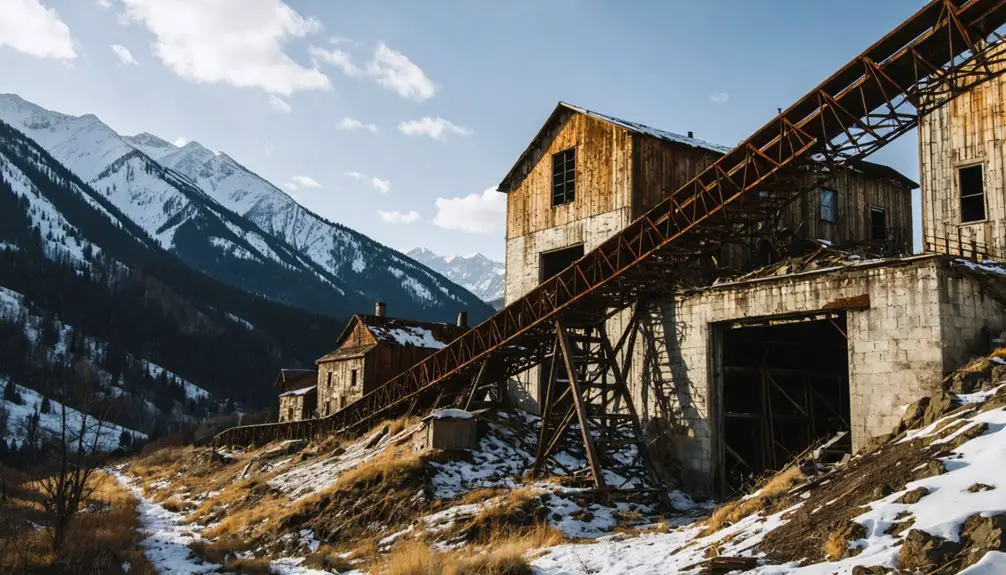
You’ll find that Standardville’s darkest hour came during the violent 1922 nationwide coal strike, when a local sheriff was killed during heated labor clashes.
The strike highlighted deep ethnic tensions between immigrant and native-born miners, with immigrant workers often assigned more dangerous tasks and facing workplace discrimination.
Desperate miners and their families resorted to trading food for coal work, underscoring the economic vulnerability of those living in this company-controlled town.
Strike Violence of 1922
During the summer of 1922, Standardville became a focal point of violent labor unrest when striking miners clashed with strikebreakers in a deadly shootout on June 14. The confrontation left one mine guard dead and several others wounded.
As ethnic tensions escalated, armed mobs targeted Greek businesses and took Greek immigrants hostage, threatening them with lynching. Strike tactics intensified after miners faced a 30% wage cut, leading the governor to declare martial law and deploy National Guard troops to Carbon County.
- The violence reflected deeper racial prejudices against Greek immigrant miners
- Local media suppressed reports of mob violence against Greek businesses
- A young man from Price intervened to prevent lynching of Greek hostages
- The UMW strike involved 610,000 miners fighting wage cuts nationwide
- Greek miners faced dual persecution as both strikers and immigrants
Food for Coal Work
As post-World War II coal demand plummeted, Standardville’s miners faced an unprecedented economic crisis that forced them to work solely for food when the Standard Coal Company couldn’t meet payroll.
You’ll find this desperate arrangement emerged within a tightly controlled company town, where miners had little choice but to accept these labor exchanges to feed their families.
Despite the United Mine Workers of America’s presence in Utah’s coalfields, Standardville’s workers remained vulnerable to the company’s dominance over local resources.
The mine’s economic struggles triggered widespread food shortages, leading to a mass exodus of families from the once-thriving community.
This unsustainable system of working for basic sustenance ultimately failed, and the mine went bankrupt, marking a dark chapter in Standardville’s history before its decline into a ghost town.
The Final Days of Mining Operations
While World War II had initially sustained coal production at around 2,000 tons daily, Standardville’s mining operations faced mounting challenges by the late 1940s.
The Spring Canyon Coal Company took over operations in 1948, but their mining techniques couldn’t overcome the declining demand for coal.
Despite new ownership and methods, Spring Canyon Coal Company couldn’t revive the struggling mine amid falling coal demand.
Despite the community’s resilience through decades of hardship, including working for food during the tough years, the mine’s fate was sealed by 1950.
- Production dwindled from peak outputs of 150,000 tons annually
- Advanced infrastructure, including the all-steel tipple, couldn’t prevent closure
- Most families left as essential services shut down
- Two determined families remained until the 1970s
- The ghost town’s structures now stand as a monument to America’s coal mining heritage
Legacy in the American West
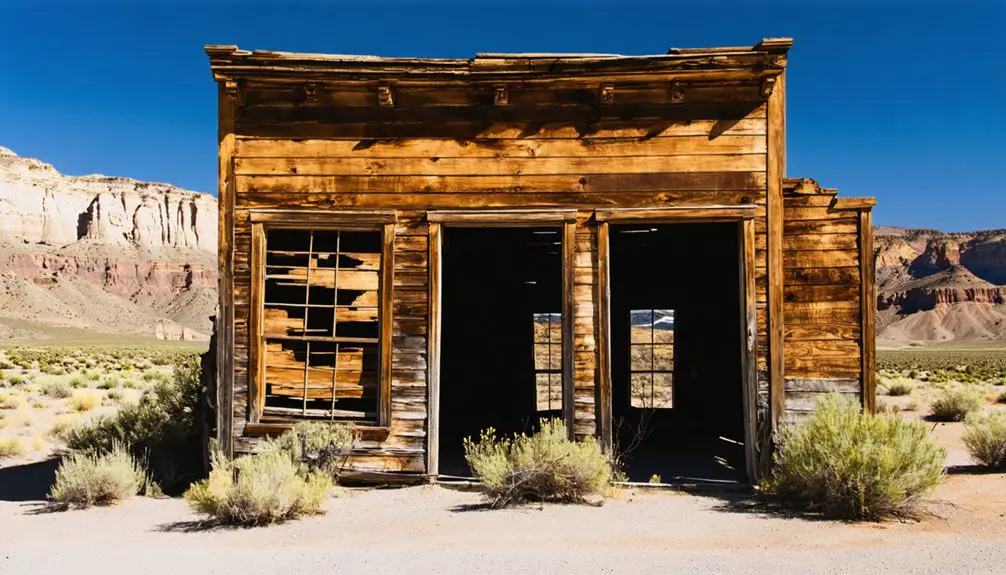
The legacy of Standardville extends far beyond its final days as a mining operation.
You’ll find its influence in the pioneering standards it set for mining town development, featuring modern amenities that were rare in the early 1900s – from steam-heated apartments to a sophisticated sewer system.
The town’s community resilience shone through multiple challenges, including the devastating 1930 mine explosion and periods when miners worked for food to keep operations running.
Standardville’s mining innovations weren’t just in coal extraction, but in creating a self-sufficient community model with schools, hospitals, and recreation facilities.
Even today, you can see how its “standard” town planning influenced other Western mining communities, proving that industrial settlements could prioritize both productivity and quality of life.
Frequently Asked Questions
Are There Any Remaining Structures Visitors Can Safely Explore Today?
You can’t safely explore any remaining structures today. For exploration safety and visitor guidelines, only view the unstable coal tipple and bathhouse ruins from outside while walking the area.
What Happened to the Mining Equipment After the Town Was Abandoned?
Like silent sentinels frozen in time, most mining machinery rusted where it stood, with no equipment preservation efforts after 1950. You’ll find some equipment was damaged by disasters or claimed by nature.
Were There Any Notable Archaeological Findings in the Ghost Town Site?
You’ll find archaeological significance in Chinese artifacts, residential structures from 1869, coal mining remains, and a concrete tipple – all providing essential historical context about early Utah mining communities.
Can Visitors Collect Artifacts or Souvenirs From the Standardville Site?
Like a guardian of history, you can’t legally collect artifacts from the site. Artifact preservation laws protect these remnants, and souvenir ethics require leaving items undisturbed for future generations to study.
What Are the Current Property Ownership and Access Rights to Standardville?
You’ll need to verify property boundaries and access regulations with Carbon County, as private ownership isn’t clearly documented since Van Horn Gas and Oil Company’s 1958 acquisition of the site.
References
- https://jacobbarlow.com/2020/02/25/standardville-utah/
- https://en.wikipedia.org/wiki/Standardville
- https://www.houseofhighways.com/nearby/usa/west/utah/standardville
- https://www.rarenewspapers.com/view/618549?list_url=/list?list_results_format=standard%25page=94%25per_page=200%25q%5Bexclude_text%5D=cata%25q%5Bsearch_method%5D=All+Words%25sort=items.id%25sort_direction=ASC
- https://anotherlanguage.org/projects/2014/ghosttown/standardville/standardville.html
- https://www.legendsofamerica.com/standardville-utah/
- https://jacobbarlow.com/2022/11/21/standardville/
- https://utahrails.net/utahcoal/standard-coal.php
- https://onlineutah.com/standardvillehistory.shtml
- https://www.youtube.com/watch?v=v4kFg7qj9uk
